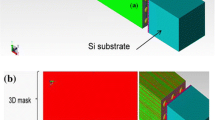Abstract
This paper presents a simple and effective method for fabricating a polydimethyl-siloxane (PDMS) microlens array with a high fill factor. The proposed method utilizes the UV proximity printing and photoresist replication methods. A concave microlens array mold is made using a printing gap in a lithography process. Optical UV light diffraction of UV light is used to deflect light away from the aperture edges to produce a certain exposure in the photo-resist material outside the aperture edges. This method can precisely control the geometric profile of a concave microlens array. The experimental results show that a concave micro-lens array can be formed automatically in photo-resist when the printing gap ranges from 240 to 720 μm. A high fill factor microlens array can be produced when the control pitch distance between the adjacent apertures of the concave microlens array is decreased to the aperture size.











Similar content being viewed by others
References
Borrelli NF (1994) Efficiency of microlens array for projection, LCD 44th electronic components and technology conf, pp 338–345
Chen J, Wang W, Fang J, Varahramyan K (2004) Variable-focusing microlens with microfluidic chip. J Micromech Microeng 14:675–680
Cheng LW (2001) Fabrication and analysis of diffractive optical elements, thesis of Department of Physics, National Central University, pp 51–52
Cho SR, Kim J, Oh KS, Yang SK, Baek JM, Jang DH, Kim TI, Jeon H (2002) Enhanced optical coupling performance in an nGaAs photodiode integrated with wet-etched microlens. IEEE 122 Photon Technol Lett 14(3):378–380
Fu Y, Annbryan NK (2002) Semiconductor microlens fabricated by one-step focused ion beam direct writing. IEEE Tran Semicond Manufact 15(2):229–231
Fu Y, Annbryan NK, Shing ON (2000) Integrated micro-cylindrical lens with laser diode for single-mode fiber coupling. IEEE Photon Technol Lett 12(9):1213–1215
Hoshino K, Shimoyama I (2001) An elastic thin-film micro-lens array with a pneumatic actuator. IEEE 321–324
Itakura K, Nobusada T, Kokusenya N, Nagayoshi R, Ozaki M (2000) A 1-mm 50 k-pixel IT CCD image sensor for miniature camera system. IEEE Tran Elect Dev 47(1):65–70
Leggatt JS, Hutley MC (1991) Microlens arrays for interconnection of single-mode fiber arrays. Electron Lett 27:238–240
Lin CP, Yang H, Chao CK (2003) A new microlens array fabrication method using UV proximity printing. J Micromech Microeng 13:748–757
Plummer JD (2000) Silicon VLSI technology. Prentice Hall, NJ, pp 208–234
Popovic ZD, Sprague RA, Neville Connell GA (1988) Technique for monolithic fabrication of microlens arrays. Appl Opt 27(7):1281–1284
Sinzinger S, Jahns J (1999) Microoptics. Wiley-VCH Verlag GmbH, Weinheim, pp. 6–10
Smith GP (1989) Some recent advances in glasses and glass–ceramics. Mater Des 10(2): 54–63
Stern MB, Jay TR (1994) Dry etching for coherent refractive microlens arrays. Opt Eng 33(11): 3547–3551
Watanabe K, Morita T, Kometani R (2004) Nanoimprint using three-dimensional microlens mold made by focused-ion-beam chemical vapor deposition. J Vacuum Sci Technol B: Microelectron Nanom Struct 22:22–26
Xia Y, Whitesides GM (1998) Soft lithography. Angewandte Chemie International Edition 37:550–575
Yang H, Chao CK, Wei MK, Lin CP (2004) High fill-factor microlens array mold insert fabrication using a thermal reflow process. J Micromech Microeng 1197–1204
Acknowledgment
This work was supported by the National Science Council (series no. NSC94-2212-E-005-016) of Taiwan, R.O.C.
Author information
Authors and Affiliations
Corresponding author
Rights and permissions
About this article
Cite this article
Lin, TH., Yang, H. & Chao, CK. Concave microlens array mold fabrication in photoresist using UV proximity printing. Microsyst Technol 13, 1537–1543 (2007). https://doi.org/10.1007/s00542-006-0264-2
Received:
Accepted:
Published:
Issue Date:
DOI: https://doi.org/10.1007/s00542-006-0264-2




